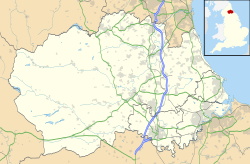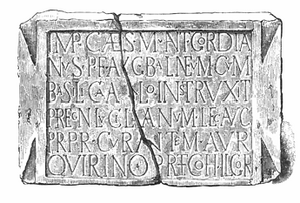Longovicium facts for kids
Quick facts for kids Longovicium |
|
|---|---|

Roman walls of Longovicium
|
|
| Known also as | Lanchester Roman Fort |
| Founded | c. 150 AD |
| Abandoned | c. 5th century AD |
| Attested by |
|
| Place in the Roman world | |
| Province | Britannia |
| Administrative unit | Britannia Inferior |
| Structure | |
| — Stone structure — | |
| Stationed military units | |
| — Legions — | |
| XX Valeria Victrix | |
| — Cohorts — | |
|
|
| Location | |
| Coordinates | 54°48′58″N 1°45′18″W / 54.816°N 1.755°W |
| Place name | Lanchester |
| Town | Durham |
| County | County Durham |
| Country | England |
| Reference | |
| UK-OSNG reference | NZ158468 |
Longovicium, also known as Lanchester Roman Fort, was an important Roman army fort in England. It was built by the Romans to help guard a main road called Dere Street. You can find its remains near Lanchester in County Durham, about 8 miles (13 km) west of Durham city.
Contents
What's in a Name?
The name Longovicium comes from an old British language called Brittonic. The first part, *longo-, means "ship." The second part, wīg, means "settlement" or "warrior." So, the name might mean "ship settlement" or "warrior settlement." It could also be linked to a local tribe called the Longovices.
History of the Fort
Longovicium was built on high ground, giving the Roman soldiers a clear view of the area. It was located between two other Roman forts, Vindomora (Ebchester) and Vinovia (Binchester), along Dere Street. This road was very important, connecting Eboracum (modern-day York) with Hadrian's Wall.
A special stone slab found at the site tells us that the Legio XX Valeria Victrix (the Twentieth Legion) built the fort. Experts believe the fort was built around 150 AD. It was later rebuilt two times, once around 230-240 AD and again in the early 4th century.
The fort is mentioned in old Roman documents, like the Notitia Dignitatum and the Ravenna Cosmography.
What the Fort Looked Like
The fort was shaped like a rectangle with rounded corners. It had four gates and was surrounded by a ditch for protection. Even though archaeologists haven't fully dug up the site, they've used special equipment to find traces of buildings. They've found the remains of the main headquarters, a bathhouse, and some barracks where soldiers lived.
Outside the fort, there was a small civilian settlement called a vicus. You can still see signs of it from aerial photos. A cemetery was also found nearby, where people were buried or cremated. The fort's location on unploughed fields means it's still in good condition, even though some stones have been taken over time.
A stone column, likely from the fort commander's house, can now be seen in the local All Saints' Parish Church. An altar dedicated to the goddess Garmangabis was also found there.
Water Supply and Engineering
Longovicium was special because it had a very good water supply. Two aqueducts brought water to the fort. One of these aqueducts got its water from 21 springs. The dam that held this water was about 20 feet (6 meters) high and 110 yards (100 meters) long. It was built with stone on the outside and clay on the inside to prevent leaks.
This aqueduct was a great example of Roman engineering. It's considered one of the best-preserved aqueducts in Britain. There was also a reservoir near the fort to store the water. While other Roman sites like the Dolaucothi Gold Mines had more aqueducts for mining, the large water supply at Longovicium suggests it was used for something important.
Fort Industry
The large amount of water used at Longovicium might have been for the baths and latrines, but it was probably also for industry. Archaeologists have found a lot of metal waste, like slag and cinders, at the site. This suggests that a lot of metalworking or smelting (melting metal) happened inside the fort or in the nearby civilian settlement.
This could mean that Longovicium was home to an Armamentarium, which was a place where weapons were made and stored. This would have supplied weapons to Longovicium and other nearby forts. The huge water supply might have even powered watermills used for forging (shaping) iron products.
Many altars, dedication slabs, and a milestone dedicated to Emperor Gordian III have been found near the fort. These stones tell us a lot about the people who lived and worked there. They show that people worshipped Roman gods like Jupiter, Mars, Mercury, and Silvanus, as well as Celtic and Germanic gods like Garmangabis.
Who Guarded the Fort?
Over the years, different groups of Roman soldiers were stationed at Longovicium.
First Century AD
In the 1st century AD, two stones show that the Cohors Primae Fida Vardulorum Milliaria Equitata Civium Romanorum was present. This was a unit of soldiers from Hispania Tarraconensis (modern-day northern Spain). These soldiers were known as the "First Cohort of Faithful Varduli," and they were a thousand strong, partly on horseback, and Roman citizens. This unit also served at other forts in Britain.
Later Centuries
Later, in the 3rd century AD (around 238 and 244 AD), other stone inscriptions tell us that the Cohors Primae Lingonum (the First Cohort of Lingones) was at the fort. These soldiers came from the Bourgogne region of France, near Dijon. There was also a small group of Suebians from Lusitania (modern-day Portugal) present at this time.
By the 4th century AD, the fort was guarded by a local unit called the Longovicians. These were irregular soldiers, partly on horseback, and commanded by Roman knights.
Future Plans for Longovicium
There are plans to open the Longovicium site to the public and turn it into a tourist attraction. The Friends of Longovicium society, Durham County Council, Durham University, and Newcastle University are working together with the landowner to make this happen. They also hope to do more archaeological digs in the future. This project is worth a lot of money, and the County Council is working with English Heritage to get the necessary funds.
Images for kids
See also
 In Spanish: Longovicium para niños
In Spanish: Longovicium para niños





